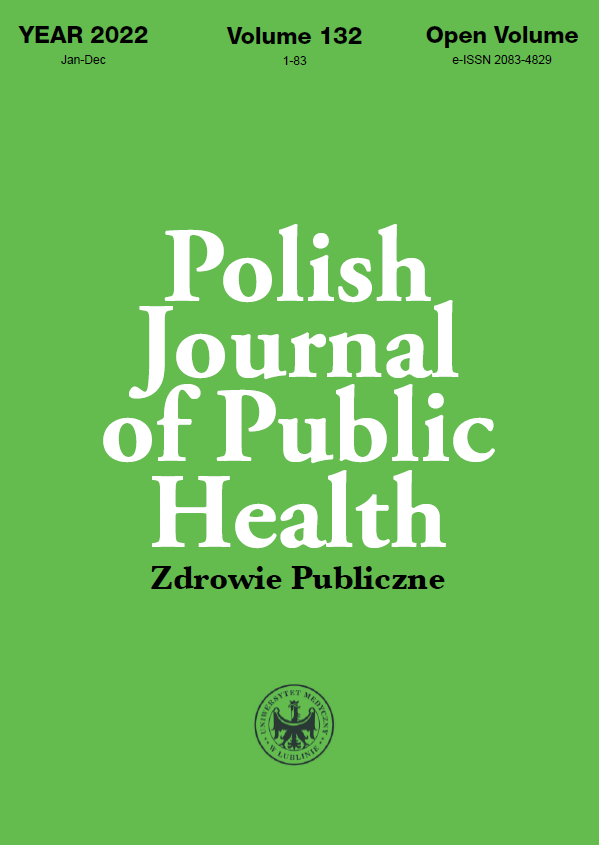A common concentration-response function based on the results applying lags
DOI:
https://doi.org/10.2478/pjph-2022-0014Keywords:
ambient air pollution, concentration-response function, log-linear modellingAbstract
Introduction. Estimating the impact of short-term exposure on health outcomes needs knowledge of both the profile and magnitude of the relative risks. This motivates constructions of practical and reliable concentration-response functions (C-RFs).
Aim. To define a practical method of finding concentration-response parametric function whose adjustable parameters can be tuned by data-driven well established routines.
Material and methods. Mortality data for the period from 1987 to 2015 (10,592 consecutive days) in Montreal, Canada, are used for illustrative purposes. Exposure to ambient ozone measured by its concentration levels is considered health risk. Concentration-response function is built using statistical modelling, conditional Poisson regression, natural spline technique, and a rudimentary hierarchical data clustering. The case-crossover design is applied to fit the model of C-RF to the mortality data consisting of daily counts of non-accidental deaths.
Results. Log-linear models of the concentration-response functions were computed for the concentrations and cofactors data lagged by 0 to 7 days; the results were statistically significant within this range of lags. The effectiveness of fitting was confirmed by reliable statistical tests. Digital routines were created to perform all computational tasks; software codes (written for R software platform) are included. The C-RF specifying the current responses to the cumulative exposure in several previous days can be obtained from the responses to lagged exposures.
Conclusions. The proposed method of concentration-response function estimation appears practical and effective in producing reliable results. The constructed function is a parametric and monotonic non-decreasing.
References
1. Szyszkowicz M, de Angelis N. Ambient air pollution and emergency department visits in Toronto, Canada. Environ Sci Pollut Res Int. 2021;28(22):28789-96.
2. Szyszkowicz M, Schoen S, de Angelis N. Air Pollution and Emergency Department Visits for Disease of the Genitourinary System. Environ Health Insights. 2021;15:11786302211025360.
3. Hoek G, Boogaard H, Knol A, et al. Concentration response functions for ultrafine particles and all-cause mortality and hospital admissions: results of a European expert panel elicitation. Environ Sci Technol. 2010,44(1):476-82.
4. Pope CA 3rd, Cropper M, Coggins J, Cohen A. Health benefits of air pollution abatement policy: Role of the shape of the concentration-response function. J Air Waste Manag Assoc. 2015;65(5):516-22.
5. Burnett R, Chen H, Szyszkowicz M, et al. Global estimates of mortality associated with long-term exposure to outdoor fine particulate matter. Proc Natl Acad Sci USA. 2018;115(38):9592-7.
6. Szyszkowicz M. Concentration – response functions for short-term exposure and air pollution health effects. Environ Epidemiol. 2018;2(2):p e011.
7. Vicedo-Cabrera AM, Sera F, Liu C, et al. Short term association between ozone and mortality: global two stage time series study in 406 locations in 20 countries. BMJ. 2020;368:m108.
8. NAPS. Environment and Climate Change Canada. 2021. National Air Pollution Surveillance Program. Retrieved from http://maps-cartes.ec.gc.ca/ rnspa-naps/data.aspx.
9. Janes H, Sheppard L, Lumley T. Case-crossover analyses of air pollution exposure data: referent selection strategies and their implications for bias. Epidemiology. 2005;16(6):717-26.
10. Szyszkowicz M. Use of generalized linear mixed models to examine the association between air pollution and health outcomes. Int J Occup Med Environ Health. 2006;19(4):224-7.
11. Armstrong BG, Gasparrini A, Tobias A. Conditional Poisson models: a flexible alternative to conditional logistic case cross-over analysis. BMC Med Res Methodol. 2014;14:122.
12. R Core Team. R: A Language and Environment for Statistical Computing; 2021. Retrieved from http://www.r-project.org/.
13. Turner H, Firth D. Generalized nonlinear models in R: An overview of the gnm package. For gnm version 1.1-1, 2020-02-02. [https://cran.r-project. org/web/packages/gnm/vignettes/gnmOverview.pdf.]
14. Nasari MM, Szyszkowicz M, Chen H, et al. A class of non-linear exposure-response models suitable for health impact assessment applicable to large cohort studies of ambient air pollution. Air Qual Atmos Health. 2016;9(8):961-72.
15. Atkinson RW, Yu D, Armstrong BG, et al. Concentration-response function for ozone and daily mortality: results from five urban and five rural U.K. populations. Environ Health Perspect. 2012;120(10):1411-7.
16. Yan M, Wilson A, Bell ML, et al. The Shape of the concentration-response association between fine particulate matter pollution and human mortality in Beijing, China, and its implications for health impact assessment. Environ Health Perspect. 2019;127(6):67007.
17. Ren M, Fang X, Li M, et al. Concentration-response relationship between PM2.5 and daily respiratory deaths in China: A systematic review and metaregression analysis of time-series Ssudies. Biomed Res Int. 2017:5806185.
18. Amoushahi S, Bayat R, Sanaei A, et al. Health and economic impacts of ambient fine particulate matter in Isfahan, Iran. Urban Climate. 2022;41:101048.
19. Gasparrini A. Distributed lag linear and non-linear models in R: The Package dlnm. J Stat Softw. 2011;43(8):1-20.
20. Szyszkowicz M, Burr WS. Distributed lag models: An analysis of Milan mortality data. J Poll Effects Control. 2014;02:1
21. Szyszkowicz M. The concentration-response functions for short-term exposure to ambient air pollution. Pol J Public Health. 2021;131:7-10.
22. Szyszkowicz M. Concentration-Response Functions as an Essence of the Results from Lags. Int J Environ Res Public Health. 2022;19(13):8116.
Downloads
Published
Issue
Section
License
Copyright (c) 2022 Authors

This work is licensed under a Creative Commons Attribution-NonCommercial-NoDerivatives 3.0 Unported License.


